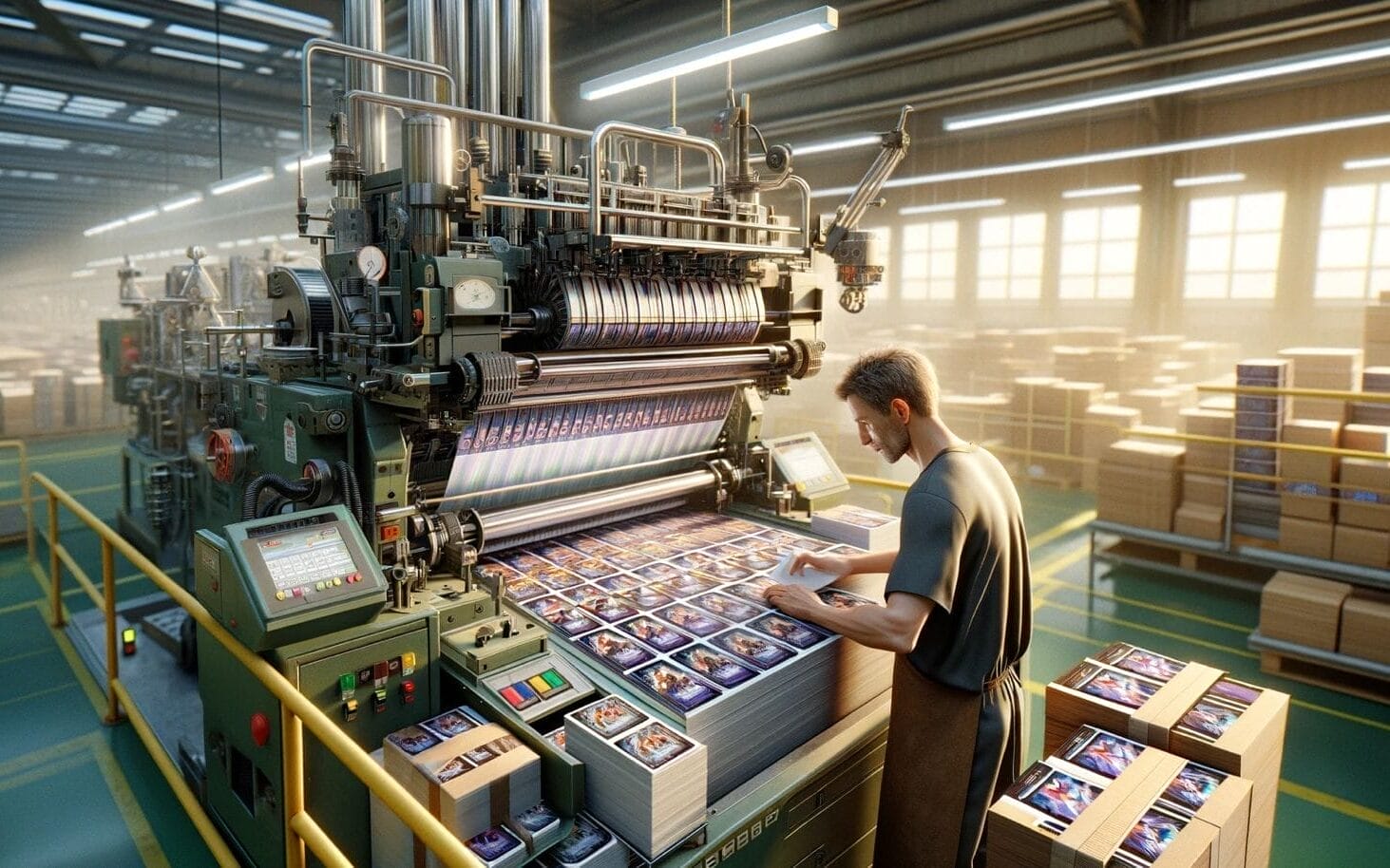
I. Introduction
Trading cards have played a significant role in our culture and society, serving as a bridge between fans and their favorite sports or entertainment figures, allowing them to own a piece of their idols’ legacy. These cards have not only been a source of joy and nostalgia but have also become a form of investment. The trading card industry has evolved into a multi-billion dollar market, reflecting their importance in our society.
The market for trading cards has been on a steady upward trajectory for the past two decades. A perfect storm of events in the last couple of years, including inflation fears, low interest rates, and uncertainty around traditional markets, has pushed investors toward alternative and tangible assets like trading cards. Celebrities and influencers have also helped spread the gospel of trading cards on social media, attracting a younger demographic.
The production of these small pieces of collectible history is a massive industry in itself. Trading card manufacturers are the unsung heroes behind the scenes, creating the cards that fans and collectors covet. These manufacturers are responsible for everything from the design and printing of the cards to ensuring their quality and rarity.
In this blog post, we will delve into the world of trading card manufacturers, exploring the titans of the industry that have shaped the landscape of trading cards as we know it today. We will take a closer look at the major players in the industry, their histories, and the impact they have had on the collectibles industry.
Table of Contents
II. Understanding Trading Cards
Trading cards – those pocket-sized pieces of cardboard – hold a universe of fascination. But what exactly are they? Let’s delve into the world of trading cards, exploring their history, their cultural significance, and the diverse types they encompass.
Trading cards, as the name suggests, are small cards designed for collecting and trading. They originated in the 19th century, tucked into cigarette packs as a marketing gimmick. Fast forward to today, and they’ve evolved into a multi-billion dollar industry, with cards spanning a multitude of themes and interests.
People collect all types of trading cards for a variety of reasons. Some are drawn to the thrill of the hunt, seeking out rare and valuable cards. Others enjoy the social aspect, trading with friends and fellow collectors. And then there are those who see trading cards as an investment, banking on their value increasing over time. Regardless of the reason, one thing remains constant: every trading card tells a story. Whether it’s a sports card showcasing a player’s stats, a gaming card detailing a mythical creature’s abilities, or a collectible card capturing a moment from a beloved movie, each card offers a glimpse into a larger world.
Delving Deep into Different Types of Trading Cards
Trading cards encompass varied interests and hobbies, with each card type offering a unique collecting journey.
Sports Cards
Sports trading cards or sports cards, as they are popularly known, made their initial appearance around the year 1886. These cards, released by Goodwin Tobacco, were a part of a baseball card set featuring 12 players from the New York Giants, and were known as the N167 set. Interestingly these cards were more than just collector’s items back in the day, as they were designed to stiffen the packaging of tobacco products they accompanied.
Presently, major sports leagues in the United States, including the National Football League (NFL), National Basketball Association (NBA), National Hockey League (NHL), Major League Baseball (MLB), etc., have exclusive contracts with singular card manufacturing firms to produce these cards.
Non-Sports Cards
Non-sports trading cards have a diverse mix of themes, from exotic wildlife and celebrated entertainment figures to landmarks around the globe, providing an educational or entertainment spin. Many non-sports cards drew inspiration from popular culture, such as popular movies and TV series. Think Star Trek, Lord of the Rings, Disney movies, Planet of the Apes, and you will get an idea of how these cards maneuvered their way into the hearts of collectors.
Collectible Card Games (CCGs) and Trading Card Games (TCGs)
Collectible Card Games (CCGs) and Trading Card Games (TCGs) are a type of card game where each player has their own deck, and the game is played using a predefined set of rules. They have become one of the types of trading cards that young people interact with the most. Icons in this domain include some of the most popular trading cards like Magic: The Gathering, Pokemon, and Yu-Gi-Oh! The cards feature fantastical artwork and serve as integral elements of the gameplay.
Art Cards
Art adds an aesthetic dimension to card culture, which brings us to Art Cards or Artist Trading Cards. These are miniature art pieces crafted for exchange and not sale. Their subjects and art styles can travel the whole range of human emotion and creativity.
From the heart-thumping arena of sports cards to the magical realms of gaming cards, and the cinematic galaxies of collectible cards, the world of trading cards is a rich and rewarding one. It’s a hobby that can last a lifetime, and who knows? You might just find that elusive card you’ve been searching for.
III. The Titans of the Trading Card World
In the realm of trading cards, several manufacturers have emerged as the titans of the industry. These companies have shaped the landscape of trading cards, contributing to the rich tapestry of the collectible card world. Let’s take a closer look at the major players in this industry.
1. Topps
Topps, a trading card powerhouse, began humbly in New York in the early 20th century. Over the years, Topps has evolved to become one of the leading manufacturers in the trading card industry. Known for their high-quality sports cards, Topps has been instrumental in bringing the world of sports closer to fans and collectors.
2. Upper Deck
When Upper Deck debuted in the baseball card scene in 1989, they caused a frenzy in the hobby world. With their high-quality cards and innovative designs, Upper Deck quickly became a favorite among collectors. Today, they continue to produce unique and sought-after cards that capture the essence of the sports world.
3. Panini
Despite being one of the youngest card brands in the hobby, Panini America has emerged as one of the biggest players in the industry. With offerings like Donruss, National Treasures and Prizm, Panini has carved a unique space in the trading card world, appealing to a diverse range of collectors.
4. In The Game (ITG)
ITG may be a small company, but they have had a significant impact on the sports card hobby. Having been a hockey card brand for many years, ITG, now owned by Leaf, continues to create unique and desirable hockey cards for fans and collectors.
5. TRISTAR
TRISTAR’s sports card division produces Minor League Baseball and Wrestling Cards, catering to a niche market within the trading card industry. Their unique focus on minor league sports provides collectors with a different perspective and adds variety to the hobby 1.
6. Bowman
Bowman, a brand under the Topps umbrella, is known for their high-quality sports cards. Their focus on featuring young, up-and-coming players has made Bowman a favorite among collectors looking for rookie cards.
7. Fleer
Fleer, a now-defunct company, has left an indelible mark on the trading card world. Known for their high-quality sports cards, Fleer cards continue to be sought after by collectors, even though the company was eventually purchased by Upper Deck.
8. Donruss
Donruss, another major trading card company of the 20th century, was known for its “Rated Rookie” emblem. Though acquired by Panini in 2009, its name and likeness are still used today in various sports card products.
9. O-Pee-Chee
O-Pee-Chee, known for their imprint in ice hockey, began creating trading cards in the 1930s. Though the company no longer exists, its name is still used for many Upper Deck hockey products.
10. Leaf
Leaf Trading Cards, founded in 2010, specializes in producing sports cards that center on autographs. Even without many of the logos and licensing for professional sports, Leaf has found a niche in the market.
These titans of the trading card world have played a major role in shaping the industry as we know it today. Through their innovation, creativity, and commitment to quality, they have brought joy to millions of collectors around the world.
IV. Manufacturer Profiles
In this section, we’ll delve into the profiles of each major trading card manufacturer, discussing their histories, notable trading cards produced, and their impact on the industry.
1. Topps
Topps is a name synonymous with trading cards. Founded in the early 20th century in New York, Topps initially sold a variety of products, including chewing gum, before focusing on trading cards. They’ve produced some of the most iconic cards in the industry, including the 1952 Mickey Mantle card, one of the most coveted baseball cards of all time. Topps’ commitment to quality and innovation has solidified its position as a titan in the trading card world.
2. Upper Deck
Upper Deck stormed into the trading card scene in 1989, introducing a new level of quality and design that had never been seen before. One of their first cards, the Ken Griffey Jr. rookie card, is one of the most popular cards of all time. Upper Deck continues to push boundaries in the industry, introducing game-used memorabilia into cards and securing exclusive memorabilia contracts with iconic athletes such as Michael Jordan and Tiger Woods.
3. Panini
Panini America may be one of the youngest card brands in the hobby, but it has emerged as one of the biggest. After acquiring Donruss in 2009, Panini expanded its offerings to include popular products like Donruss, National Treasures, and Prizm. Panini’s reach extends beyond the American market, with strong ties to the soccer world, producing the FIFA World Cup sticker collection.
4. In The Game (ITG)
In The Game (ITG), though smaller in size, has had a significant impact on the trading card hobby, particularly in the hockey card domain. Now owned by Leaf, ITG continues to produce unique and desirable hockey cards, catering to a niche market within the trading card industry.
5. TRISTAR
TRISTAR’s sports card division produces Minor League Baseball and Wrestling Cards, catering to a niche market within the trading card industry. Their unique focus on minor league sports provides collectors with a different perspective and adds variety to the hobby.
6. Bowman
Bowman, a brand under the Topps umbrella, is known for their high-quality sports cards. Their focus on featuring young, up-and-coming players has made Bowman a favorite among collectors looking for rookie cards.
7. Fleer
Fleer, a now-defunct company, has left an indelible mark on the trading card world. Known for their high-quality sports cards, Fleer cards continue to be sought after by collectors, even though the company was eventually purchased by Upper Deck.
8. Donruss
Donruss, another major trading card company of the 20th century, was known for its “Rated Rookie” emblem. Though acquired by Panini in 2009, its name and likeness are still used today in various sports card products.
9. O-Pee-Chee
O-Pee-Chee, known for their imprint in ice hockey, began creating trading cards in the 1930s. Though the company no longer exists, its name is still used for many Upper Deck hockey products 2.
10. Leaf
Leaf Trading Cards, founded in 2010, specializes in producing sports cards that center on autographs. Even without many of the logos and licensing for professional sports, Leaf has found a niche in the market.
These manufacturers have played a significant role in shaping the trading card industry, providing collectors with a variety of cards to suit their interests. Through their commitment to quality, innovation, and variety, they’ve enriched the hobby and created a rich tapestry of collectible cards.
V. Behind the Scenes: How Trading Cards are Made
Creating a trading card is a meticulous process that involves several steps. From the initial design to the final product, each step contributes to the creation of a card that captures the essence of the subject it represents. Let’s delve into the process of creating trading cards, highlighting the unique processes and techniques used by the manufacturers discussed.
The Card Manufacturing Process
The process of creating a trading card generally involves the following steps:
Prepress
In the prepress stage, card designs are arranged digitally into print sheets and color separated. Plates or cylinders are output for the printing presses.
Printing
Modern sheetfed or web-fed offset presses print the card images onto paper stock at high speeds. Some products shift to digital presses for shorter runs.
Embellishing
Cards receive coatings, treatments, or special elements like memorabilia at this stage via sophisticated insertion equipment.
Cutting/Sorting
Print sheets are cut into individual cards, then sorted and collated into sets by a proprietary system unique to each product.
Packing Out
Cards are packaged randomly into foil packs, hobby boxes, or other retail formats and prepared for distribution.
Security And Quality Control
Throughout manufacturing, security measures are embedded to deter counterfeiting and ensure collectibility. Serial-numbered hologram stickers are applied to autographed and memorabilia cards. Stringent quality checks are also performed, as condition is critical for trading cards.
Serial Numbered Parallels
Numbered parallels take a base card and create a short-printed version with hobby appeal. Lower print runs increase scarcity, driving huge value as collectors chase limited editions.
The Future of Panini Printing
Investments in digital printing continue across Panini‘s manufacturing footprint. New digital presses enable shorter runs, faster turnarounds, and more versioning. Added customization and personalization of trading cards is expected as an advantage over traditional printing.
How Playing Cards Are Made
Playing cards are made from a cardstock material that has a core. The card manufacturing process involves quite a few steps. First, the client will indicate how many cards they want to have made and in what cardstock and finish. Then they will upload their art for the cards and the prepress team will review those art files. Once those digital files are approved, the team will make a PPC (preproduction copy) of the game and the cards and send it to the client for final approval. Once the PPC is approved then the game and the cards are mass produced. The artwork for the cards is laid out front and back on printing plate sheets and then it is printed onto the chosen cardstock sheets. Once the sheets are printed then they are run through a cutting machine that cuts the sheets lengthwise and then runs down a track and cut cross wise to divide up all the individual cards. The cards then go through a sorting machine that puts them into individual decks and those decks are run through a shrink-wrapping machine that binds the cards together. Those cards are then assembled into the final game box.
From the initial design to the final product, the process of creating a trading card is a complex one. It involves meticulous planning, careful execution, and a deep understanding of the card’s purpose and the collector’s needs. It’s this process that brings trading cards to life, turning them from simple pieces of cardboard into cherished collectibles.
VI. The Impact of Trading Cards Manufacturers on the Collectibles Industry
The trading card industry has seen significant growth and evolution over the years, largely thanks to the efforts of major manufacturers. These manufacturers have not only shaped the industry but have also introduced significant trends and changes that have reshaped the way collectors engage with their hobby.
Shaping the Industry Landscape
Trading card manufacturers have played a pivotal role in shaping the industry landscape. They have introduced new product lines, innovated in design and production techniques, and expanded into new markets, contributing to the diversity and richness of the trading card world. For instance, Panini America’s acquisition of Donruss in 2009 expanded its offerings to include popular products like Donruss, National Treasures, and Prizm, providing a unique space in the trading card world.
The Rise of Digital Printing
Investments in digital printing continue across Panini‘s manufacturing footprint. New digital presses enable shorter runs, faster turnarounds, and more versioning. Added customization and personalization of trading cards is expected as an advantage over traditional printing. This shift towards digital printing is a significant trend in the industry, allowing manufacturers to produce cards more efficiently and with greater customization options.
The Boom in the Card Market
The trading card industry has seen a significant boom in recent years. The COVID-19 pandemic, for instance, pushed investors towards alternative and tangible assets, even if they were cardboard rectangles smaller than index cards. Celebrities and influencers like entrepreneur Gary Vaynerchuk, rapper Drake, and YouTube star Logan Paul spread the gospel on social media. Cancellations of in-person events forced fans to find other ways to engage with their passions. New categories of collectibles, including sneakers and non-fungible tokens, helped attract a younger demographic.
The Future of the Collectibles Industry
The future of the collectibles industry looks promising, with significant growth opportunities and drivers. The global Collectible Trading Cards Market Research Report 2023 examines every aspect of the industry, including recent trends, business prospects, market risks, and significant market drivers, in addition to the market’s CAGR. The research also offers a thorough primary analysis of the market, covering the major players, sectors, product types (Entertainment, Favorites), applications (Sports Card, Non-sports Cards), and industry chain structure.
The trading card manufacturers have played a significant role in shaping the trading cards industry, providing collectors with a variety of cards to suit their interests. Through their commitment to quality, innovation, and variety, they’ve enriched the hobby and created a rich tapestry of collectible cards.
VII. The Future of Trading Cards Manufacturing
As we look towards the future of trading cards manufacturing, several trends and changes are shaping the landscape. These trends indicate a promising future for the industry, with potential opportunities for manufacturers to adapt and innovate.
Technological Advancements
The trading card game industry is becoming increasingly technologically oriented due to technological advancements. As consumer disposable incomes increase and demand for collectible trading game cards grows globally, manufacturers are poised to enjoy prosperous, lucrative, and auspicious benefits in the near future. The appeal of collectible trading cards is that they serve as collectible items that represent the characters, objects, and settings from players’ favorite franchises and enable them to engage in trading card games .
Investment Trend
Interest in trading cards as an investment has taken off during the pandemic, making it more difficult to acquire cards and leading to new ways of getting them. Younger people are treating cards like stocks or bonds. The trend, which roughly began in late 2019, picked up steam at such a rapid pace that big box stores, such as Target and Walmart, have implemented strict policies that limit customers to one box of cards. Pokemon cards, sports memorabilia, NFTs, and Funko (FNKO) figurines are becoming alternative investments like fine art or vintage wines. Investing in sports cards has finally caught up with the digital era.
Sports Betting Industry
The sports betting industry keeps breaking monthly revenue records and shows no signs of slowing down. The trading game card players are highly indulged in drawing similar consumer demographics via the sports card industry via investing or adopting strategies to boom sports card games.
Market Growth
The trading card game market is likely to experience unprecedented growth in the future. According to the Market Statsville Group (MSG), in 2021, the market for collectible card games is expected to grow over USD 22,171.3 million, and by the end of 2030, it is anticipated to reach around USD 178,899.0 million, with a CAGR of 26.3%.
Market Size and Outlook
The trading cards market size is expected to grow from 2022 to 2029. The global trading cards market is segmented by type, application, and region. The market dynamics of the trading cards market include the developments in technology, the challenges and opportunities, and the economic impact on the trading cards industry.
In conclusion, the future of trading cards manufacturing looks promising with the potential for significant growth and innovation. As manufacturers adapt to these trends, they will continue to shape the industry and provide collectors with a variety of cards to suit their interests.
VIII. Conclusion
In this blog post, we’ve explored the world of trading cards, delving into their history, cultural significance, and the diverse types they encompass. We’ve introduced the major trading card manufacturers and provided a brief overview of each, discussing their histories, notable trading cards produced, and their impact on the industry. We’ve also delved into the process of creating trading cards, highlighting the unique processes and techniques used by these manufacturers.
The trading card industry has seen significant growth and evolution over the years, largely thanks to the efforts of major manufacturers. These manufacturers have not only shaped the industry but have also introduced significant trends and changes that have reshaped the way collectors engage with their hobby.
Looking towards the future, the trading card game industry is becoming increasingly technologically oriented due to technological advancements. Interest in trading cards as an investment has taken off during the pandemic, making it more difficult to acquire cards and leading to new ways of getting them. The sports betting industry keeps breaking monthly revenue records and shows no signs of slowing down. The trading game card players are highly indulged in drawing similar consumer demographics via the sports card industry via investing or adopting strategies to boom sports card games.
In conclusion, the future of trading cards manufacturing looks promising with the potential for significant growth and innovation. As manufacturers adapt to these trends, they will continue to shape the industry and provide collectors with a variety of cards to suit their interests.
But what about you? As a collector, what are your thoughts on the future of trading cards? How do you see the industry evolving? And what kind of cards are you most excited about collecting next? We’d love to hear your thoughts in the comments below. Let’s continue the conversation and explore the exciting world of trading cards together.








